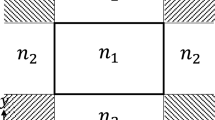Abstract
Time-domain local-operator methods have proven valuable in simulating electromagnetic phenomena from DC to light with simple and complex media. Certain limitations do exist with the time-domain local-operator methods including wall-clock simulation times and cells per wavelength requirements. This work achieves lower simulation times through code optimizations, algorithm optimizations and parallelism. This yields faster simulations times and lower cell per wavelength requirements. The improved method has been applied to a set of optical problems.
Similar content being viewed by others
References
Cole, J.B. A High-Accuracy Realization of the Yee Algorithm Using Non-Standard Finite Differences. IEEE Transactions on Microwave Theory and Techniques 45(6) 991–996, 1997.
Colella, P. and P.R. Woodward. The Piecewise Parabolic method (PPM) for Gas-Dynamical Simulations. Journal of Computational Physics 54 174–201, 1984.
Hadi, M.F. and M. Piket-May. A Modified FDTD (2, 4) Scheme for Modeling Electrically Large Structures with High-Phase Accuracy. IEEE Transactions on Antennas and Propagation 45(2) 254–264, 1997.
Hayes, P.R. Transmission-Line Matrix Modeling. Master's thesis, Auburn University, 1990.
Sawdey, A., M. O'Keefe and R. Bleck. The Design, Implementation, and Performance of a Parallal Ocean Circulation Model. In Proceedings of the Sixth ECMWF Workshop on the Use of Parallel Processors in Meteorology: Coming of Age, eds. G. Hoffman and N. Kreitz, 523–550, 1994.
Shang, J.S. Characteristic Based Methods for the Time-Domain Maxwell Equations. In 29th Aerospace Sciences Meeting, No. AIAA 91-0606, 1–14. American Institute of Aeronautics and Astronautics, 1991.
Shang, J.S. Characteristic-Based Algorithms for Solving the Maxwell Equations in the Time Domain. IEEE Antennas and Propagation Magazine 37(3) 15–25, 1995.
Shankar, V., W.F. Hall and A.H. Mohammadian. A Time-Domain Differential Solver for Electromagnetic Scattering Problems. Proceedings of the IEEE 77(5) 709–721, 1989.
Shankar, V., W.F. Hall, A. Mohammadian and C. Rowell. Algorithmic Aspects and Supercomputing Trends in Computational Electromagnetics. In 31st Aerospace Sciences Meeting & Exhibit, No. AIAA 93-0367, 1–24. American Institute of Aeronautics and Astronautics, 1993.
Strang, G. On The Construction And Comparison Of Difference Schemes. SIAM Journal of Numerical Analysis 5(3) 506–517, 1968.
Taflove, A. Computational Electrodynamics: The Finite-Difference Time-Domain Method. Artech House, Inc, 1995.
Woodward, P.R. and P. Colella. The Numerical Simulation of Two-Dimensional Fluid Flow with Strong Shocks. Journal of Computational Physics 54 115–173, 1984.
Yee, K.S. Numerical Solution of Initial Boundary Value Problems Involving Maxwell's Equations in Isotropic Media. IEEE Transactions on Antennas and Propagation AP-14(4) 302–307, 1996.
Author information
Authors and Affiliations
Rights and permissions
About this article
Cite this article
Hayes, P.R., O'keefe, M.T., Woodward, P.R. et al. Higher-order-compact time-domain numerical simulation of optical waveguides. Optical and Quantum Electronics 31, 813–826 (1999). https://doi.org/10.1023/A:1006998830374
Issue Date:
DOI: https://doi.org/10.1023/A:1006998830374




